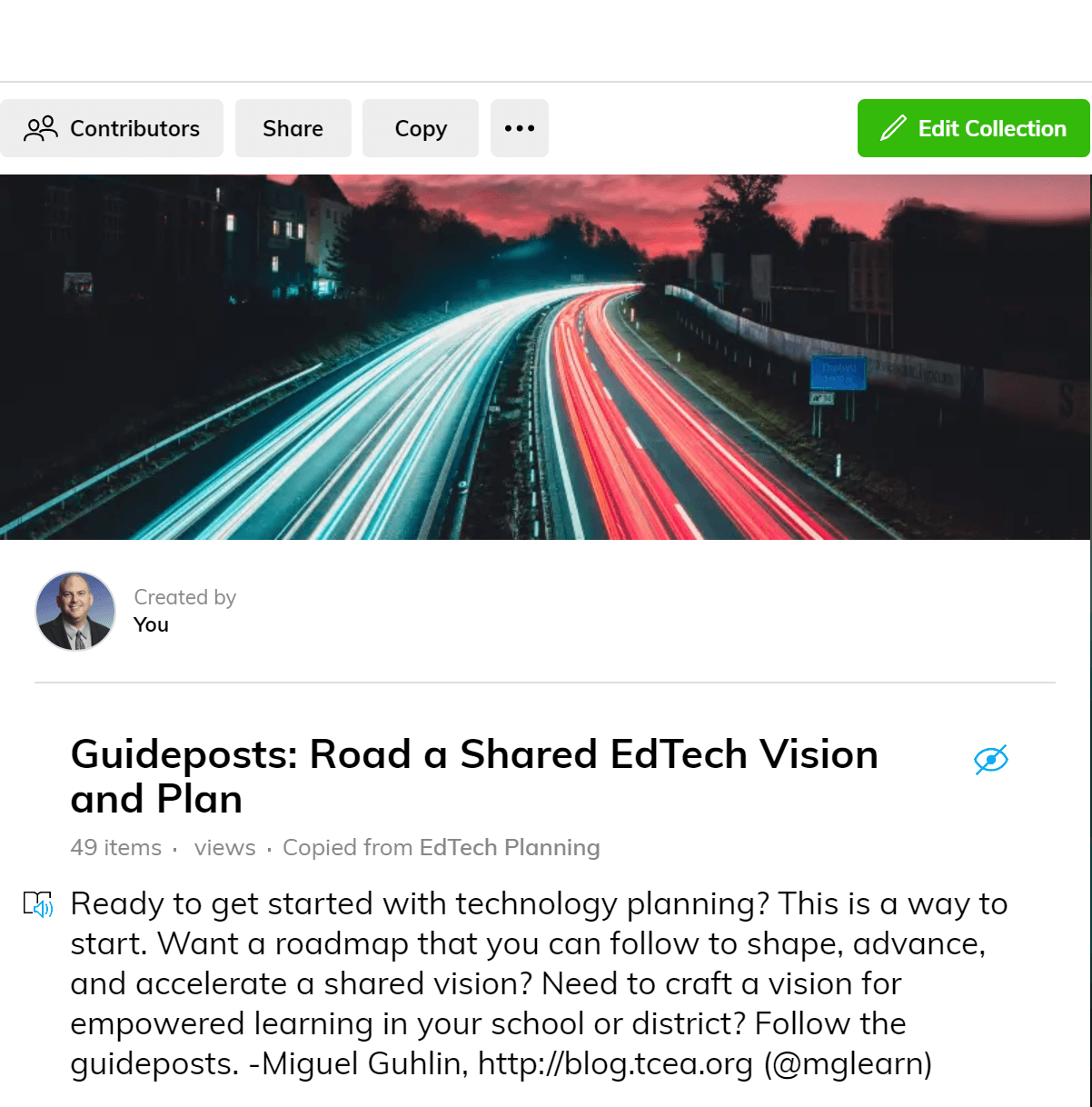Want a road map that you can follow to shape, advance, and accelerate a shared vision? Need to craft a vision for empowered learning in your school or district? In this blog entry, we’ll explore a few key concepts and ideas. You will also get access to rich repository of curated ed technology planning content.
Start with Why
“What I’m starting to gain a greater appreciation for is that the best results are achieved…by talking about the why,” says Julie Zhuo. In every school district I’ve had the opportunity to serve, roadblocks to planning come up. If I’d known then what I know now, I would have made every effort to start with why. As Simon Sinek points out in his viral TED talk, most of us often begin with what. For educational technology enthusiasts, the what and the how are enchanting places to begin. For superintendents who say, “Let’s put iPads in the hands of every child,” it’s about the what. For many technology directors, figuring out how is the job they embrace. Seldom is why addressed since it’s easier to assume that everyone knows the why.
In this blog entry, we’ll explore some key points any veteran campaigner knows. Those just starting out, though, will find this an invaluable roadmap of guideposts.
Guidepost #1: Problem Definition
“The formulation of the problem is often more essential than its solution,” said Albert Einstein. When we skip the why, we often avoid the problem. After discussing the why, it’s critical we jump into defining the problem. You can use any variety of problem definition strategies you like. Some include engineering design process, the Big 6, Six Sigma, and crucial conversations.
A well-defined problem often contains its own solution within it. That solution is usually quite obvious and straightforward. Define problems well, you make them easier to solve. This means saving time, money and resources. Source: Entrepreneur
Bill Lewis (CTO, Seguin ISD) suggests the following steps. Each is essential to solving the problem of ed tech visioning and planning:
- Create a year-round collaborative environment that fosters relationships between instruction and technology.
- Keep board and district goals aligned.
- Create a process where the instructional needs drive all decisions.
- Be intentional with the integration of technology and instruction.
- Address the infrastructure needs of technology to support student and staff needs.
To ensure the success of the vision, the ed tech plan must reflect the problems the organization faces. That is to say, it must take into account the goals, culture, and pedagogical vision. To the degree that it does not, it fails to capture the problem and reveal the solution. The best way to achieve this is through meetings with stakeholders. Remember that it’s not the plan that’s important; rather, it’s the planning process that shapes the future.
Guidepost #2: Aspirational Standards
“What are we here to do?…What is the best alignment between what we have to offer and what people need?” asks Irene Au. Often, technology plans lack a connection to their why. The stakeholders themselves may not even know the why. These next two guideposts put the why square in their sights.
Two quick ways to focus stakeholders are to share frameworks and standards with them. One framework of skills you could share includes Tony Wagner’s Seven Survival Skills. The skills, says Wagner, are transferable and designed to empower students to harness the changes the future brings, such as artificial intelligence (see Wakelet of resources on the rise of AI).
Looking for standards that target the knowledge and behaviors leaders, teachers, and students need? The power of standards is that they present unifying vocabulary everyone can use. This is quite powerful and allows you to shift the conversation in your district.
Guidepost #3: Instructional Needs
“The technology we introduce must serve a purpose. That purpose must be to enhance learning through improving pedagogy,” says Dr. Michael Cowling. Dr. Cowling (Senior Lecturer of Educational Technology) goes on to say, “Simply using technology for technology’s sake just doesn’t cut it.”
American students face a crisis. No, really, they are. According to Marc Tucker’s book, Leading High-Performance School Systems, we have some work to do. Tucker points out (watch the video):
- Research shows the U.S. now has one of the worst educated workforces in the industrialized world.
- Millennials, the core of the workforce, are now among the least well educated.
- Americans ages 16-34 are at the bottom of the ETS survey on reading, numeracy, and problem solving.
Worse, as cited in this TCEA TechNotes blog entry, current technology usage leaves much to be desired. In fact, Lori Gracey shares the following takeaway:
“High levels of technology use in the classroom tend to correlate with lower student performance.”
Rather than hide this information, we need to shout it from the rooftops. The reason why is that research-based strategies, strategies that work, and maximizing instructional time are more important than ever. Technology is essential to our future success. The future places higher-order literacy demands on all. It’s critical and urgent that our children know how to read, write, and think and to be able to do all of those at a very high level.
Technology can be a part of the solution, but it’s not the silver bullet many of us hoped for. How it fits in is the subject of the next guidepost. In that guidepost, we will prepare to answer the question, “Does technology make a significant difference?”
Guidepost #4: Digital Teaching and Learning
“We need technology in every classroom and in every student and teacher’s hand. It is the pen and paper of our time. It is the lens through which we experience much of our world,” says David Warlick. Let’s answer the question of how technology can make a significant difference.
Technology use in schools has centered around various approaches, such as the following:
- Constructivist approach: It is a paradigm or worldview. This approach suggests that learning is an active, constructive process and the learner is an information constructor. People construct or create their own subjective representations of objective reality.
- Project-based learning (PBL): We have explored various PBL approaches here at TechNotes. And here’s a Wakelet you can look at as well.
- One-to-one device: This approach suggests that giving every student may result in significant gains. The truth is, “It depends.”
Others (e.g. blended learning, flipped learning, STEM/STEAM) have advocates as well. The truth is no approach works unless we include and focus on high academic standards for students.
Once on the job, teachers continue to get training, or “professional development,” that has little basis in science. And their supervisors and instructional materials often assume the validity of non-evidence-based practices. (Source: Natalie Wexler, Three Reasons Classroom Practice Conflicts with Evidence on How Kids Learn. Forbes.com.)
Want to ensure technology makes a significant difference? Then make sure that it’s readily available, enjoys fast internet connections, and scaffolds communication and collaboration. Aside from that, put in place evidence-based practices. That may mean retraining your teachers and introducing them to evidence-based practices. Then doing everything to support their transition. Need support on how to make the transition? Check TCEA’s Research-based Practices and empowerED program.
Providing greater access to technology and the Internet don’t make any difference in learning UNLESS the teaching is also changed. (Source: Latif Jameel, “Will Technology Transform Education for the Better?” as cited in TechNotes)
Guidepost #5: Assessing Technology
“There is WiFi on Mt Everest! There are ZERO excuses for our students to not have WiFi access in their schools and homes,” says-Tom Murray. As an educator, it is important to understand the various lenses you can use to observe and assess the use of technology.
These frameworks serve as aids to campus administrators who may not understand what to look for in the classroom. Given the high stakes of what’s happening in the classroom, research-based assessments are a must. There are various approaches you can take to assess the effect of technology. One suggestion is to NOT link it to student achievement. Instead, focus on using technology as a way to enhance the effectiveness of professionals’ work.
- Approach #1 – Technology audit. Make sure your technology infrastructure is ready to go.
- Approach #2 – Gauge stakeholder insight. To do this, consider gathering data. One way is to use the Clarity Brightbytes survey as a benchmark assessment.
- Approach #3 – Deploy educational framework. There are various frameworks. Find an overview online. Not all frameworks have the research background.
These three approaches can make or break your technology planning effort. John Hattie suggests that the T3 Framework can maximize the impact of most technological interventions. But keep in mind that progress can only happen if we change the dominant “tell and practice” teaching model.
Facilitate District Visioning and Planning
Looking for a way to facilitate school-changing conversations? TCEA can make this a reality for you. This multi-meeting process guides your stakeholder group through planning for real, lasting change. It involves developing a district technology plan vision, goals, and strategies. A quick overview includes:
- A technology audit
- Multiple meetings to study audit results and transform those into strategies and goals
- Crafting examples strategies
- Reviewing technology plan formulation
- Putting the new plan into an attractive format
Having skilled facilitators to assist you is a relief. Ready to start your journey? Contact TCEA’s Executive Director, Lori Gracey.
 As you might imagine, navigating the guideposts may be difficult. But it can be easier if you remember what your role in shaping an ed tech vision and plan can be. Rather than advocating for unproven innovations, empower people to see a way ahead that research supports. In that way, you make possible a learning journey for all stakeholders.
As you might imagine, navigating the guideposts may be difficult. But it can be easier if you remember what your role in shaping an ed tech vision and plan can be. Rather than advocating for unproven innovations, empower people to see a way ahead that research supports. In that way, you make possible a learning journey for all stakeholders.
As promised, here’s the technology planning Wakelet full of amazing resources you can use now.

